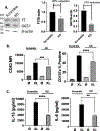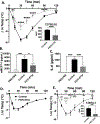Inhibiting Isoprenylation Suppresses FcεRI-Mediated Mast Cell Function and Allergic Inflammation
- PMID: 37449905
- PMCID: PMC10545418
- DOI: 10.4049/jimmunol.2200862
Inhibiting Isoprenylation Suppresses FcεRI-Mediated Mast Cell Function and Allergic Inflammation
Abstract
IgE-mediated mast cell activation is a driving force in allergic disease in need of novel interventions. Statins, long used to lower serum cholesterol, have been shown in multiple large-cohort studies to reduce asthma severity. We previously found that statins inhibit IgE-induced mast cell function, but these effects varied widely among mouse strains and human donors, likely due to the upregulation of the statin target, 3-hydroxy-3-methylgutaryl-CoA reductase. Statin inhibition of mast cell function appeared to be mediated not by cholesterol reduction but by suppressing protein isoprenylation events that use cholesterol pathway intermediates. Therefore, we sought to circumvent statin resistance by targeting isoprenylation. Using genetic depletion of the isoprenylation enzymes farnesyltransferase and geranylgeranyl transferase 1 or their substrate K-Ras, we show a significant reduction in FcεRI-mediated degranulation and cytokine production. Furthermore, similar effects were observed with pharmacological inhibition with the dual farnesyltransferase and geranylgeranyl transferase 1 inhibitor FGTI-2734. Our data indicate that both transferases must be inhibited to reduce mast cell function and that K-Ras is a critical isoprenylation target. Importantly, FGTI-2734 was effective in vivo, suppressing mast cell-dependent anaphylaxis, allergic pulmonary inflammation, and airway hyperresponsiveness. Collectively, these findings suggest that K-Ras is among the isoprenylation substrates critical for FcεRI-induced mast cell function and reveal isoprenylation as a new means of targeting allergic disease.
Copyright © 2023 by The American Association of Immunologists, Inc.
Conflict of interest statement
No other authors have conflicts of interest to declare.
Figures








Similar articles
-
Utility of mast cell P815 for evaluating FcεRI-dependent and FcεRI-independent allergic effects.Allergol Immunopathol (Madr). 2025 Jul 1;53(4):119-127. doi: 10.15586/aei.v53i4.1264. eCollection 2025. Allergol Immunopathol (Madr). 2025. PMID: 40682236
-
Omeprazole inhibits IgE-mediated mast cell activation and allergic inflammation induced by ingested allergen in mice.J Allergy Clin Immunol. 2020 Oct;146(4):884-893.e5. doi: 10.1016/j.jaci.2020.02.032. Epub 2020 Mar 16. J Allergy Clin Immunol. 2020. PMID: 32194041 Free PMC article.
-
Topical antihistamines and mast cell stabilisers for treating seasonal and perennial allergic conjunctivitis.Cochrane Database Syst Rev. 2015 Jun 1;2015(6):CD009566. doi: 10.1002/14651858.CD009566.pub2. Cochrane Database Syst Rev. 2015. PMID: 26028608 Free PMC article.
-
Vaccine-Induced Anti-IgE Antibodies Neutralize Free IgE but Fail to Bind and Activate Mast Cell-Displayed IgE.Allergy. 2025 Jul;80(7):1995-2007. doi: 10.1111/all.16530. Epub 2025 Apr 7. Allergy. 2025. PMID: 40192411 Free PMC article.
-
Statins for Smith-Lemli-Opitz syndrome.Cochrane Database Syst Rev. 2022 Nov 14;11(11):CD013521. doi: 10.1002/14651858.CD013521.pub2. Cochrane Database Syst Rev. 2022. PMID: 36373961 Free PMC article.
Cited by
-
Protein lipidation in health and disease: molecular basis, physiological function and pathological implication.Signal Transduct Target Ther. 2024 Mar 15;9(1):60. doi: 10.1038/s41392-024-01759-7. Signal Transduct Target Ther. 2024. PMID: 38485938 Free PMC article. Review.
-
Single-cell multiomics reveals simvastatin inhibits pan-cancer epithelial-mesenchymal transition via the MEK/ERK pathway in XBP1+ mast cells.Sci Rep. 2024 Nov 28;14(1):29545. doi: 10.1038/s41598-024-80858-5. Sci Rep. 2024. PMID: 39604504 Free PMC article.
References
-
- Galli SJ, Maurer M, and Lantz CS. 1999. Mast cells as sentinels of innate immunity. Current Opinion in Immunology 11: 53–59. - PubMed
-
- Kinet JP 1999. The high-affinity IgE receptor (Fc epsilon RI): from physiology to pathology. Annu Rev Immunol 17: 931–972. - PubMed
-
- Kitaura J, Song J, Tsai M, Asai K, Maeda-Yamamoto M, Mocsai A, Kawakami Y, Liu F-T, Lowell CA, Barisas BG, Galli SJ, and Kawakami T. 2003. Evidence that IgE molecules mediate a spectrum of effects on mast cell survival and activation via aggregation of the FcεRI. Proceedings of the National Academy of Sciences 100: 12911–12916. - PMC - PubMed
Publication types
MeSH terms
Substances
Grants and funding
LinkOut - more resources
Full Text Sources
Medical
Miscellaneous

